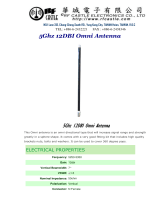ICP DAS USA SST-2450 User manual
- Category
- Networking
- Type
- User manual
This manual is also suitable for
ICP DAS USA SST-2450 is a spread spectrum radio modem designed for data acquisition and control applications, allowing communication between a host and remote sensors without the need for cable wires. It operates in the 2.4GHz frequency range with a communication range of up to 300 meters, depending on the antenna used. The SST-2450 supports both RS-232 and RS-485 interfaces and can be set using a software utility. It offers three peer-to-peer operational modes, including a sample and rebuild mode, a simulated full-duplex mode, and a simulated half-duplex mode.
ICP DAS USA SST-2450 is a spread spectrum radio modem designed for data acquisition and control applications, allowing communication between a host and remote sensors without the need for cable wires. It operates in the 2.4GHz frequency range with a communication range of up to 300 meters, depending on the antenna used. The SST-2450 supports both RS-232 and RS-485 interfaces and can be set using a software utility. It offers three peer-to-peer operational modes, including a sample and rebuild mode, a simulated full-duplex mode, and a simulated half-duplex mode.




















-
 1
1
-
 2
2
-
 3
3
-
 4
4
-
 5
5
-
 6
6
-
 7
7
-
 8
8
-
 9
9
-
 10
10
-
 11
11
-
 12
12
-
 13
13
-
 14
14
-
 15
15
-
 16
16
-
 17
17
-
 18
18
-
 19
19
-
 20
20
-
 21
21
-
 22
22
-
 23
23
-
 24
24
-
 25
25
-
 26
26
ICP DAS USA SST-2450 User manual
- Category
- Networking
- Type
- User manual
- This manual is also suitable for
ICP DAS USA SST-2450 is a spread spectrum radio modem designed for data acquisition and control applications, allowing communication between a host and remote sensors without the need for cable wires. It operates in the 2.4GHz frequency range with a communication range of up to 300 meters, depending on the antenna used. The SST-2450 supports both RS-232 and RS-485 interfaces and can be set using a software utility. It offers three peer-to-peer operational modes, including a sample and rebuild mode, a simulated full-duplex mode, and a simulated half-duplex mode.
Ask a question and I''ll find the answer in the document
Finding information in a document is now easier with AI
Related papers
-
ICP DAS USA SST-900B User manual
-
ICP DAS USA I-7188XA - Embedded Controller with 2-channel DI and DO, supports C programming and RS-485/RS-232 User manual
-
ICP DAS USA ISaGRAF User manual
-
ICP DAS USA I-7188XBD-512 (with 7 segment display) User manual
-
ICP DAS USA ISaGRAF User manual
-
ICP DAS USA SST-900B Quick Start
Other documents
-
APM AAM-2405gM User manual
-
WiFi-Link WLP-2450-12-1 Datasheet
-
 WiFi-Link WLO-5350-12 Datasheet
WiFi-Link WLO-5350-12 Datasheet
-
 WiFi-Link WLO-5775-12 Datasheet
WiFi-Link WLO-5775-12 Datasheet
-
 Harxon HX-DU8608D User manual
Harxon HX-DU8608D User manual
-
Amped Wireless WA12 Datasheet
-
Zonet ZWA3006 Quick Installation Manual
-
MicroNet SP920MA-8 Quick Installation Manual
-
Gigabyte GA-8I845GV User manual
-
Gigabyte GA-K8S760M User manual




























